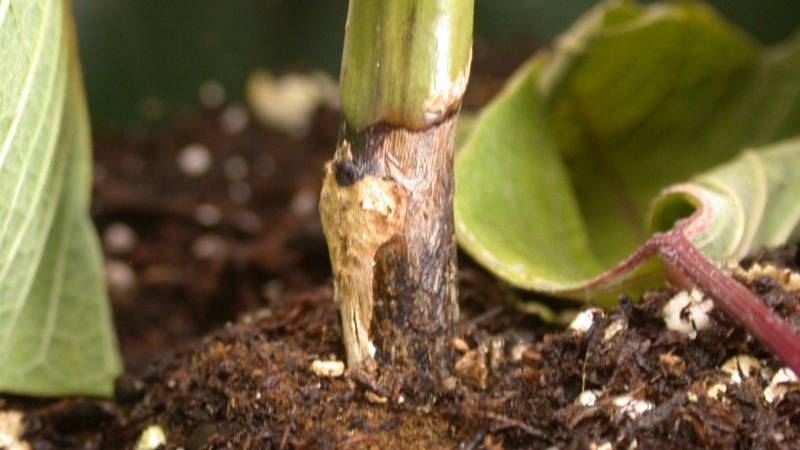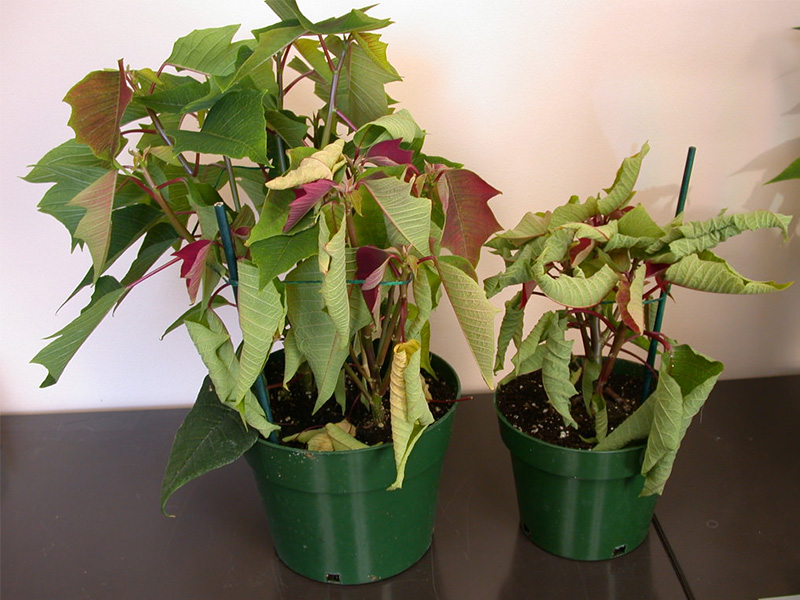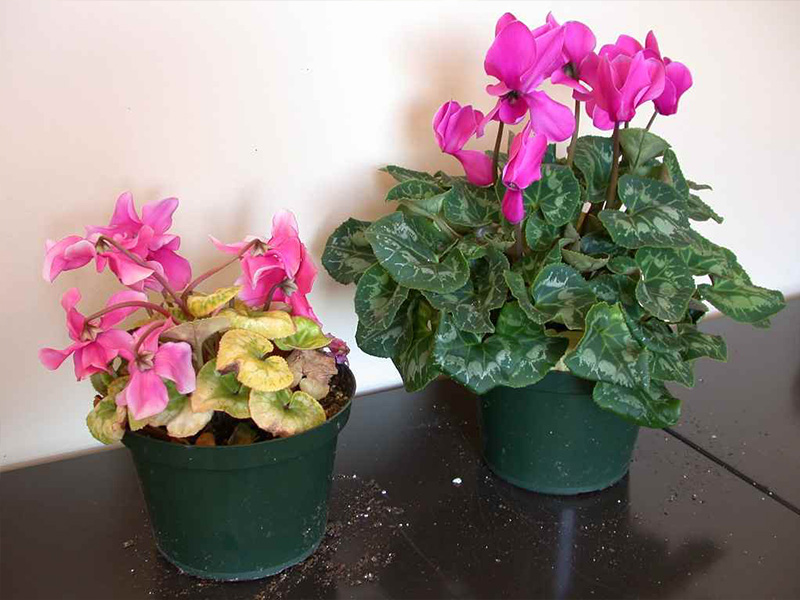Rhizoctonia Root Rot: Symptoms And How To Control


Figure 1. Rhizoctonia stem rot in poinsettia. Notice the cankers forming around the stem at the soil line. This caused this poinsettia to wilt and eventually die. Source: Premier Tech
Rhizoctonia is a soilborne fungus found naturally in outdoor soils from fields, landscapes, gardens, etc. It produces sclerotia, which are tough, brownish-black structures that allow it to survive in the soil or infected plant tissue for years.
With a wide host range, Rhizoctonia can cause a variety of diseases including stem rot, root rot, damping-off in seedlings and aerial blight of leaves (Table 1).
It is often the cause of rot in cuttings, especially those under mist. The most common species that infects plants is Rhizoctonia solani. Although there are other species known to cause plant disease, not all species of Rhizoctonia are plant pathogens.
Symptoms
Rhizoctonia grows along the upper surface of the growing medium, so it often attacks the plant stem at the soil line. Stems often decay quickly, starting with the formation of brown to reddish-brown lesions that enlarge, forming sunken cankers near the soil line (Figure 1).
Infected stems have a dry, shrivelled, “wiry” appearance. Cankers enlarge and girdle the stem, restricting the movement of water and nutrients into the plant, causing wilting, especially during the heat of the day, and possible nutrient deficiencies (Figures 2 and 3).


Aerial blight
Leaves that come in contact with the soil can become infested with Rhizoctonia, causing aerial blight. Aerial blight can spread quickly if the leaves are wet, plants are too close together and/or the humidity is high in the greenhouse.
More virulent in young plants
When Rhizoctonia causes root rot, it attacks roots that are in the upper layer of the growing medium. Seeds can be infected before germination or after emergence, leading to damping-off.
Older plants’ roots can also become infected, but Rhizoctonia is more virulent in young, tender plants. Roots diseased by Rhizoctonia turn brown and mushy, like other root rot pathogens.
| Rhizoctonia Disease | Most Susceptible Crops |
|---|---|
| Cutting Rot | Azalea, hydrangea, osteospermum, pittosporum, poinsettias, rosemary, vinca |
| Damping-off | Celosia, gomphrena, impatiens, snapdragon, stock, vinca |
| Stem Rot | Aster, dianthus, impatiens, poinsettias, pothos |
| Root Rot | Aglaonema, azalea, begonia, campanula, ferns, holly, impatiens, juniper, philodendron, poinsettias, spathiphyllum |
| Aerial Blight | Azalea, holly, juniper, pittosporum |
Pathogen Source
Most soilless growing media contain little to no Rhizoctonia due to the source and processing of components. It is often introduced as a natural contaminant from mineral soils. Therefore, avoid growing plants directly on a soil floor where water splashing can contaminate a plant or growing medium.
Minimize dust from a field, construction site, etc. from entering the growing area as it may contain Rhizoctonia. Fungus gnats and shore flies can also introduce and transmit Rhizoctonia within a crop.
Favorable Conditions for Rhizoctonia
Hot temperatures (70-90 °F or 12-32 °C) favor the growth of Rhizoctonia, so it is more problematic in late spring and summer. Rhizoctonia does not require free water for its lifecycle, so it prefers even, moderate moisture in the growing medium, not wet, saturated conditions.
Because it tends to dwell near the growing medium surface, it prefers high humidity as with all fungal pathogens. When humidity is high, brown webbing can be seen in the affected parts of the plant. Frequent misting, close spacing of plants, wet leaves/stems and lack of airflow all favor Rhizoctonia development. Therefore, it is a common problem with cuttings and young plants.
Plant susceptibility greatly increases if there are open wounds on plant parts near the soil line. These wounds serve as entry points for Rhizoctonia.
How To Control Rhizoctonia
Fungicide drenches are valuable tools to help prevent or eliminate Rhizoctonia. Biological microorganisms, such as the Bacillus bacterium found in PRO-MIX® with AGTIV® DEFEND™ and PRO-MIX® with AGTIV® FORTIFY™ growing media, will naturally suppress and reduce the incidence of Rhizoctonia.
However, biological and chemical controls are more effective when used in conjunction with good cultural practices as listed below:
- Since Rhizoctonia is a soilborne disease, do not reuse growing medium from infected plants.
- Remove diseased plants and plant residues from the growing area.
- Use brand-new containers. If the containers are reused, they must be properly sanitized or the disease will transfer to the next crop.
- Avoid contact with soil as it often is a source of Rhizoctonia.
- Water in the morning to allow leaves and stems to dry before sunset.
- Increase airflow within the plant canopy.
- Increase plant spacing to allow humidity to escape the plant canopy and try to maintain humidity levels below 93%.
- Avoid plant stress and prevent injury which can create open wounds that serve as entry points for Rhizoctonia.
- Grow plants at 70 °F (12 °C) or colder. Remember, this provides ideal conditions for other root disease organisms.
- Keep hose ends off the floor and do not allow soil contact with containers, plants or equipment.
References:
- https://extension.psu.edu/rhizoctonia
- http://www.gpnmag.com/article/rhizoctonia-diseases-ornamentals/
- http://www.greenhousegrower.com/production/crop-inputs/greenhouse-diseases-101-rhizoctonia/
- http://www.greenhousemag.com/article/greenhouse-0611-rhizoctonia-diseases-summer-plant-health/
- http://www.greenhousemag.com/article/bioworks-newsletter-rhizoctonia-control/
- Chase, A.R., M. Daughtrey and G.W. Simone. 1995. "Diseases of Annuals and Perennials: A Ball Guide: Identification and Control." Ball Publishing, Illinois.